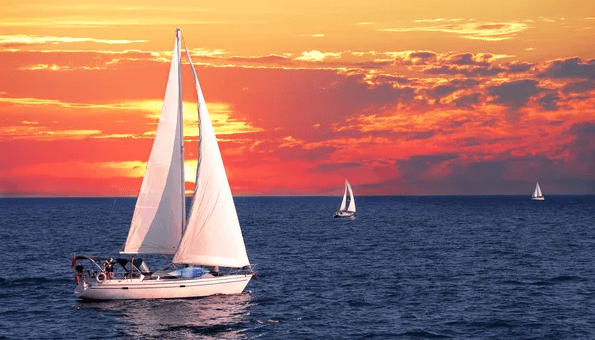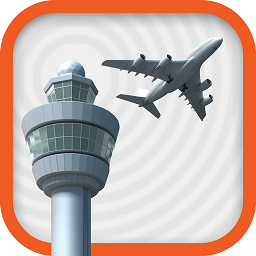624
Points
Questions
72
Answers
119
-
Asked on 4th May 2023 in Aerodynamics.
Sails are mainly used with boats. Sails are curved and it is designed in such a way that it creates a region of high pressure and low pressure around it. Sails can be compared with the wings of any airplane. On any wing there is a creation of high pressure on the bottom surface and low pressure on the upper surface. So, the upper portion of the wing is at a lower pressure and the bottom surface is at high pressure. The wing is designed in such a way that the flow of air over the top surface is at a higher speed and the flow of air at the bottom surface is at lower speed, this creates a region of lower pressure on the top surface and a region of higher pressure on the bottom surface, resulting in a net upward force of lift.
Similarly on the sail there is a lower pressure on the front side and a higher pressure on the back side due to its curved design. The flow of air on its front side is at a higher speed creating a low pressure region and the flow of air behind the sail is at a lower speed creating a high pressure region. This difference in pressure creates a net forward force like the lift of the aircraft.
This is how a sail works. So, we can say that the working of the sail in the boat is an analogy to the working of the wing on an aircraft.
- 916 views
- 1 answers
- 0 votes
-
Asked on 2nd May 2023 in Aerodynamics.
Aerodynamics is the study of flow of air over any object. When an air flows over any object there is creation of forces over it such as lift and drag. These forces are created due to pressure differences over the top and bottom surfaces.
One of the methods to learn aerodynamics is by simply visualizing. Aerodynamics can be learnt by seeing the flow of air over our car, or any other vehicles, while riding a bike, or by driving and just sitting in our cars.
When we ride any bike we have flow of air over our body, which in general gives some resistance to the flow of air. This is also aerodynamics. We can reduce the air resistance by tilting our body forward. When we are in a car and put our hand outside we also see the flow of air and feel resistance to it. These are the cases of aerodynamics. If we slightly bend our palm to the direction of flow of air then there is less drag. However, these methods should not be done at a high speed of the car, otherwise it can cause injury.
Use of aerodynamics is also in aircraft. We see aircrafts and helicopters. Aircrafts are the perfect example for the use of aerodynamics. Wings of the aircraft generate lift, which is the main source of force for uplifting the aircraft from the ground and flying in the sky. Similarly, helicopters use aerodynamics through the use of its rotor and blades in order to lift up and fly forward into the sky. Rockets and spacecraft also use aerodynamics.
Racing formula cars use streamlined bodies in order to move faster and reduce drag to a significant amount. Cricket balls are a fine example of aerodynamics. We can swing any ball by the use of seam.
In our home we can make a small wind tunnel in order to study the flow behavior over any object. Similarly, wool tufts and fan can be used to visualize the flow of air. In the present day, we can use modern technologies like computers in order to study aerodynamics with the use of computational fluid dynamics or (CFD). These are very cost efficient and are also used by many industries.
- 747 views
- 1 answers
- 0 votes
-
Asked on 28th April 2023 in Aerodynamics.
Aerodynamics is the study of flow of air over an object and its associated different flow characteristics. Aerodynamics create lift and drag. We can study the flow of air over any surface like a sphere, a ball, car and aircrafts. Study of aerodynamics helps us to understand the different types of forces created and its effect on objects.
In order to study aerodynamics, in industry or for commercial purposes wind tunnels are used. There are huge wind tunnels which are generally used for testing aerodynamics of objects for a speed flow between low subsonic to hypersonic. For all these purposes different types of wind tunnel are used. However all these wind tunnels are very costly and take a huge amount of time to manufacture or build.
We can also take simple techniques in order to make or replicate the wind tunnel. These types of techniques are not as accurate as the wind tunnel testing but can give a fair result from which we can deduce our hypothesis and correlate our speculation. Some of these techniques are like using fan and wool tufts, using water and ink, small replicas of a wind tunnel, using smoke and others. We can also use the softwares in order to simulate the aerodynamic behaviors.
Using fan and wool tufts can give us a fair amount of idea about the direction and behavior of air flow over the object. We can also simulate by using water and dyes or using ink in order to get similar behavior. With the use of fan and smoke we will also have a fair idea about the behavior of flow over any object.
Nowadays with the advancement of computation technologies we have many softwares which can do our simulation faster and more accurately then the wind tunnel test and at a lower cost. Computational fluid dynamics is the field which is used now in industry as well as we can also use it in our home through the use of computers. The results of CFD are more accurate and can simulate real world scenarios. It has highly reduced the cost as well as time which is otherwise generally taken by wind tunnel testing.
- 752 views
- 1 answers
- 0 votes
-
Asked on 26th April 2023 in Aerodynamics.
Aerodynamics is the study of science which is related to flow of air. We are all surrounded by air and we live and also take breath in order to sustain our lives. We have made control on water and developed ships and boats in order to travel through water. Similarly we have made airplanes and spaceships in order to travel through air. So with respect to air we can say that it plays a leading role in order to fly in the sky and to travel.
We all are surrounded by air and inorder to take its advantages as well as overcome disadvantages we need to know its characteristics. So we need to study the air, and it is aerodynamics. When an object is flying through the sky it is generating two forces, lift and drag. Lift is a force which makes the object fly in the sky, whereas drag opposes its forward motion. So in order to encounter or balance lift we have to weigh the object. In general Lift = Weight . In order to encounter drag, there is thrust which is created by the engine. So drag is countered by thrust or we can say that Drag = Thrust.
On any vehicle including cars, it can experience all these four types of forces. When a car travels at a very high speed it is experiencing all these types of four forces. At slow speed, there is no such effect, however as the speed of the car increases, there is an increase in its degrading effect.
First of all the most important is the drag, which has a very large effect on its speed itself. When there is a large speed, there is also a very large drag due to the large flow of air over its surfaces. So, in order to overcome the drag, there are some methods which can be implemented in order to reduce this. Once such a method is about making the body streamlined. A streamlined body has a smoother flow of air around its body, having less drag. So we generally see that the body of a car now has an oval shape rather than the blunt shape like in our earlier days. An oval shape is more streamlined than the blunt shape, so it is reducing the drag and also increases fuel efficiency. When we have less drag it also means that we will have less fuel consumption so thereby increasing car or engine efficiency.
Another way of improving the car aerodynamics is by using spoilers at the end, which is also called, the rear deck spoiler. The main purpose of this is to reduce the uplift force which is usually created at a very high speed due to flow of air beneath it. Active air dams are also used on the front side of the vehicle, in order to give the vehicle more stability, and also adjust and redirect the flow of air, in order to have greater fuel efficiency. Lowering of the car height at a large speed also can be used to improve aerodynamics, as it creates a downward force.
- 869 views
- 1 answers
- 0 votes
-
Asked on 22nd January 2023 in Aerodynamics.
Aerodynamics is the study of flow of air and its interaction with the body. Here the article is about how does aerodynamics work on cars and how does aerodynamics affect the speed of a car. This article is also about how to make a car more aerodynamic. Need of study aerodynamics is required to improve the performance of any vehicle. Car aerodynamics simulation in the wind tunnel as well as in simulation software are carried out to know the aerodynamic results. There are both advantages and disadvantages of aerodynamics in cars. There are two forces which are created by the flow of air on the vehicle. One is the drag force and the other is the lift force.
Car aerodynamics engineers carry out the car aerodynamics test and car aerodynamics diagram to increase the car aerodynamics fuel efficiency and modify the car aerodynamics parts. Here the car aerodynamics is explained. The lift force can uplift the vehicle from the road when moving at a very high speed. The drag force provides resistance to the vehicle. Both forces need to be seen as they create detrimental effects on the car or any vehicle’s performance. So aerodynamics plays a very crucial role in vehicle design. The main use of aerodynamics is to optimize car performance by minimizing its fuel use, maximizing its stability, decreasing the sound inside the car – air whistling sound may be created otherwise, to remove the stucking of dirt from the road into the car.
In order to obtain a high aerodynamic efficiency in a car the body of the car should be of streamlined shape, a low frontal area and minimum opening in the body, these are also the features of race car aerodynamics. The car’s exterior body should be slippery so that there is very less drag. Spoilers and side skirts are there in order to manipulate air flow and improve downforce. Aerodynamics features are generally based on speed, however acceleration, yaw rate, steering wheel angle and brakes can also come into play. Tire vents in the car body allow the air to cool the tire and brakes, vanes and fins direct airflow which create a downward force and improve the stability of the car.
Rear spoilers retract at a certain speed to give stability and reduce drag. Rear flaps in the car are used to increase air extraction capacity under the car while the front vertical flaps are used to generate downforce in order to balance each other. Flaps also direct air inside the car for engine cooling.
- 864 views
- 1 answers
- 0 votes
-
Asked on 17th January 2023 in Aerodynamics.
Aerodynamics means dynamics of air as the name suggests. Aerodynamics is the study of flow of air around an object. Where there is an atmosphere there is air. Like our planet earth there is atmosphere in Mars, Venus and other planets. Aerodynamics is an important field for aeronautics and aerospace engineering.
The basic concept for working of aerodynamics consists of 4 forces. These forces are Lift, Weight, Thrust and Drag. All these forces come into play when any object is in the air. Lift balances the weight of the object. So any body when it is in air either flying or thrown upward these two forces act in the perpendicular direction. Lift is in the opposite direction of weight and both forces balance each other when any object is flying. Lift in an airplane is generated by the wings.
Thrust and drag are the two forces which act parallel to the flying object. Thrust makes any flying object to gain forward motion or we can say to oppose the drag force. When any object is moving forward there is an equal and opposite force generated and that is the drag. So we can say that in order to move forward we need to overcome drag and this is achieved by engines of airplanes which produce the thrust.
A bird’s wing generates both lift and thrust in order to balance its weight and drag force and fly.
- 845 views
- 1 answers
- 0 votes
-
Asked on 16th January 2023 in Aerodynamics.
The aerodynamics of a cow will be as a blunt object. The air mostly sees the front of a body and then flows according to the shape pattern behind. Earlier the experiments were done in the wind tunnel to determine and know the flow pattern of air over the object. The experiment shows the streamline flow of air over an object whose shape is oval or streamline like the airfoil. These kinds of objects can generate lift if its shape is little bit changed making flow over the airfoil little faster than the flow down the airfoil. So by modifying the shapes a varying amount of lift can be generated. These types of bodies are known as a body of aerodynamic shapes.
Unlike the aerodynamic streamline bodies, a body which obstructs the flow of air is a blunt body. These types of bodies create the largest amount of drag and very less amount of lift. Blunt bodies are non streamlined bodies, like cuboid, spherical and cylindrical shapes. These bodies obstruct the flow of air.
So any bodies which are blunt will not produce any streamline flow of air. Even cars and other vehicles are now designed to have an aerodynamic shape so that there is very less drag on a vehicle, making it to have an advantage of low consumption of fuel and higher speed. Animals like cheetahs which run very fast make their body streamlined to achieve a very high speed while running. Cows and other herbivorous animals do not run for prey, so their body need not be streamlined for a smoother, faster flow of air.
- 839 views
- 1 answers
- 0 votes
-
Asked on 28th January 2022 in Aerodynamics.
Here, \alpha = 5^{\circ}=0.0873\,rad,\, M = 2.5From linearized theory, for a flat plate at an angle of attack c_{l}=\frac{4\alpha }{\sqrt{M_{\infty}^{2}-1}}Therefore, c_{l}=\frac{4\left ( 0.0873 \right )}{\sqrt{\left ( 2.5 \right )^{2}-1}}=0.1524c_{d}=\frac{4\alpha ^{2}}{\sqrt{M_{\infty}^{2}-1}}Therefore, c_{d}=\frac{4\left ( 0.0873 \right )^{2}}{\sqrt{\left ( 2.5 \right )^{2}-1}}=0.0133C_{p}=\frac{2\theta}{\sqrt{M_{\infty}^{2}-1}}Therefore,C_{p}=\frac{2\left ( 0.0873 \right )}{\sqrt{\left ( 2.5 \right )^{2}-1}}=0.0762
- 1121 views
- 1 answers
- 0 votes
-
Asked on 17th January 2022 in Aerodynamics.
From isentropic flow properties table, for M_{\infty}=0.52,\frac{p_{0}}{p_{\infty}}=1.202
for, M_{\infty}=0.82, \frac{p_{0}}{p_{\infty}}=1.555
Coefficient of pressure is C_{p}=\frac{p-p_{\infty}}{q_{\infty}}=\frac{p-p_{\infty}}{\frac{\gamma }{2}p_{\infty}M_{\infty}^{2}}=\frac{2}{\gamma M_{\infty}^{2}}\left ( \frac{p}{p_{\infty}}-1 \right )\frac{p}{p_{\infty}}=\frac{\frac{p}{p_{\infty}}}{\frac{p_{0}}{p}}=\frac{1.202}{1.555}
Therefore, C_{p}=\frac{2}{\left ( 1.4 \right )\left ( 0.52 \right )^{2}}\left ( \frac{1.202}{1.555}-1 \right )=-1.199
Coefficient of pressure can also be calculated by using the formula,
C_{p}=\frac{2}{\gamma M_{\infty}^{2}}\left [ \left ( \frac{1+\left ( \frac{\gamma -1}{2} \right ){M_{\infty}^{2}}}{1+\left ( \frac{\gamma -1}{2} \right )M^{2}} \right )^{\frac{\gamma }{\gamma -1}} – 1\right ]\Rightarrow \frac{2}{\left ( 1.4 \right )\left ( 0.52 \right )^{2}}\left [ \left ( \frac{1+\left ( \frac{1.4 -1}{2} \right ){\left ( 0.52 \right )^{2}}}{1+\left ( \frac{1.4 -1}{2} \right )\left ( 0.82 \right )^{2}} \right )^{\frac{1.4 }{1.4 -1}} – 1\right ]=-1.1984- 1124 views
- 1 answers
- 0 votes
-
Asked on 8th December 2021 in Systems.
The infrastructure of air traffic management is constituted by communication, navigation and surveillance of aircrafts.
Communication: Communication refers to the exchange of voice and data in between pilot and air traffic controllers. Communication is done through high frequency, very high frequency and ultra high frequency systems and through communication satellites.
The function of air traffic controllers is to direct the aircrafts which are on the ground and also which are in controlled airspace. It also provides advisory services to aircrafts which are in non-controlled airspace.
ATC prevents aircraft collisions and organizes aircraft traffic. ATC monitors the aircraft through radars and communications are made with pilots with the help of radio.
Navigation: Navigation of aircraft means plan, record and control the movement of aircrafts from accurate and reliable determination of position. Navigation of aircraft is done through visual flight rules and instrument flight rules. In visual flight rules aircraft navigation is made by visual observations and dead reckoning using maps. Dead reckoning is the calculation of current position from previous determined position, and using speed, heading direction and time.
Instrument flight rules: Instrument flight rule uses instruments and radio navigation aids like beacons. Navigations aids like distance measuring equipment (DME), very high frequency omni-directional range(VOR), non-directional beacon (NDB) and global positioning system (GPS) and Global navigation satellite system (GNSS) are used.
Inertial navigation system uses computer, sensors like accelerometers and gyroscopes to calculate position, orientation and velocity of aircraft. Inertial guidance system is now also combined with satellite navigation systems.
Surveillance: Aircraft surveillance system is divided into two types, a dependent surveillance and an independent surveillance. In dependent surveillance or a cooperative system, the position of the aircraft is determined from on-board navigation equipment and then conveyed by the pilot to air traffic control through voice reporting.
Secondary surveillance radar on the ground communicates with transponders on the aircraft to find the position and other details of the aircraft. Position of aircraft can also be determined through global navigation satellite system (GNSS).
Automatic dependent surveillance – Broadcast(ADS-B) determines aircraft position from satellite navigation and other sensors and broadcasts periodically to the air traffic control ground stations. Other aircrafts can also receive the information (from ADS-B) which can be used for awareness and self-separation.
 Automatic Dependent Surveillance - Broadcast
Automatic Dependent Surveillance - Broadcast Independent surveillance or non-cooperative systems uses instruments on the ground such as primary surveillance radar or secondary surveillance radar measures range and azimuth of the aircraft from ground station by transmitting pulses of radio waves which then reflects off from the aircraft’s hull.
- 1108 views
- 1 answers
- 0 votes
















